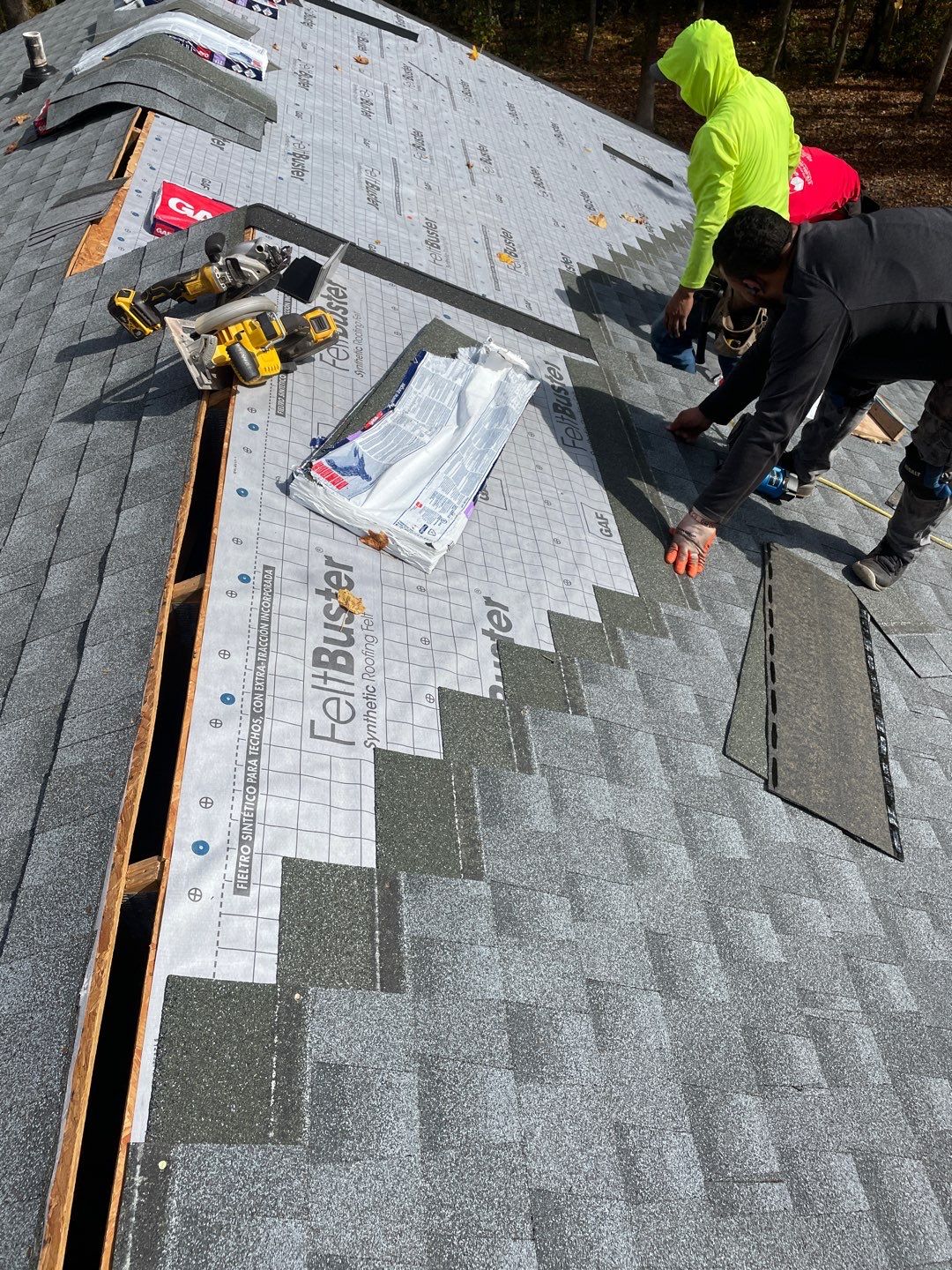Evaluating the Solutions Supplied by Roofing Companies in Gainesville Florida
Evaluating the Solutions Supplied by Roofing Companies in Gainesville Florida
Blog Article
Ideal Practices for Ensuring Correct Roof Ventilation
Making sure proper roof air flow is crucial for the durability and efficiency of a roof. A well balanced intake and exhaust air vent ratio, typically 1:300, plays a pivotal duty, with consumption vents ideally placed at the lower edge of the roofing for cool air access and exhaust vents at the height for warm air exit. Regular inspections to determine obstructions and keep clear airflow are critical. Maintaining insulation away from vents is important to prevent airflow limitation. Comprehending these fundamental elements establishes the phase for more thorough insights right into installment and maintenance practices that can substantially boost your roof system's performance.
Understand Ventilation Basics
Effectively comprehending air flow basics is essential for making certain the long life and effectiveness of roof. Reliable ventilation alleviates wetness buildup and temperature extremes in the attic, both of which can bring about substantial structural damage over time. A well-ventilated roofing helps in preventing typical concerns such as mold and mildew development, wood rot, and ice dams, which can endanger the integrity of the roof materials and the underlying structures.
The key goal of air flow is to assist in the movement of air, permitting a regular exchange between the outdoor and interior settings. This balance is attained with a combination of intake and exhaust vents that interact to keep optimal air movement. Consumption vents, typically situated along the eaves or soffits, allow fresh air to enter the attic room space, while exhaust vents, often located at or near the roofing system ridge, enable warm, moist air to run away.
Trick factors influencing the effectiveness of roofing ventilation consist of appropriate positioning, sufficient sizing, and guaranteeing that both intake and exhaust vents are unblocked. Regular assessment and maintenance are critical to recognize possible blockages, damages, or inefficiencies in the ventilation system, consequently protecting the roofing's performance and longevity.
Kinds Of Roof Covering Vents
Roof covering vents play a vital duty in maintaining efficient attic room ventilation and, by expansion, the general wellness of the roofing system. Numerous types of roofing vents are readily available, each with one-of-a-kind advantages tailored to certain roofing needs.

Soffit vents are installed under the eaves and job in tandem with roof vents to guarantee a well balanced consumption and exhaust system. By enabling cooler air to get in from below, soffit vents assist in the expulsion of warm air with upper vents. Gable vents, located on the outside wall surfaces of the attic, offer one more efficient solution, particularly in homes with saddleback roofs.
Analyze Your Current Ventilation

Next, take into consideration the age and condition of your roof covering products and air flow parts. Older systems might not adhere to current building ordinance or might have deteriorated in time, minimizing their effectiveness. Conduct a thorough examination to identify any signs of wear and tear, such as corrosion, damages, or voids that could endanger the system's performance.
Furthermore, gauge the attic temperature and humidity levels. High temperature levels and humidity can show poor ventilation - roofing companies in gainesville florida. Use a hygrometer and thermostat to obtain precise analyses, contrasting them with exterior conditions. Persistent discrepancies suggest possible problems that need addressing.
Setup Best Practices
Efficient installment of roof covering air flow systems is extremely important for guaranteeing optimal efficiency and long life. Proper installation begins with recognizing the specific ventilation demands of the roof covering and the structure it covers. This includes computing the proper proportion of consumption to wear down vents, generally sticking to the 1:300 guideline, which stipulates one square foot of air flow for every single 300 square feet of attic floor space.

The positioning of vents is equally vital. Consumption vents ought to be mounted at the roof's reduced side, usually in the soffits, to enable trendy air to go into. Exhaust vents, on the other hand, must be mounted near or at the roof's height to browse around these guys help with the exit of cozy, wet air. This produces a natural airflow that aids preserve temperature level and wetness equilibrium within the attic space.
Seal all air vent connections meticulously to avoid air leaks and potential water infiltration. Use top quality materials and follow manufacturer guidelines to guarantee resilience and efficiency. Furthermore, incorporating ridge vents with baffles can dramatically boost airflow performance by stopping wind-driven rain and snow from entering the attic.
Inevitably, specific installation of roof air flow systems mitigates prospective problems such as mold and mildew growth, ice dams, and architectural damage, guaranteeing the roof covering's stability and the structure's total health and wellness.
Normal Maintenance Tips
Consistency in maintenance techniques is fundamental to making sure the long-lasting performance of roofing air flow systems. During these examinations, guarantee that vents are complimentary of debris, nests, and various other blockages that might restrain airflow.
Use a soft brush or a vacuum to get rid of dirt and debris from intake and exhaust vents. Be cautious not to harm the air vent displays or louvers throughout the procedure.
Proper insulation is similarly essential. Make sure that attic insulation does not block the vents, as this can drastically limit air flow. Rearrange or change it to maintain an effective barrier. if any insulation has shifted or resolved.
Lastly, change any type of damaged or missing out on elements quickly. Busted vents, fractured roof shingles, or tatty blinking can all add to poor air flow and needs to be attended to immediately. Regular upkeep guarantees that the roofing ventilation system operates ideally, thereby prolonging the life expectancy of the roof covering itself.
Conclusion
Guaranteeing proper roof covering ventilation is vital for maintaining the efficiency and toughness of a roof. Adherence to the 1:300 intake and exhaust air vent proportion, paired with the critical positioning of vents, is necessary. YOURURL.com Routine biannual inspections, debris cleaning, and ensuring insulation does not block airflow are essential practices. Carrying out these best techniques will cultivate a well-ventilated roof, therefore i thought about this mitigating potential issues connected to moisture build-up and too much heat, eventually extending the roof covering's life expectancy.
A balanced consumption and exhaust vent ratio, commonly 1:300, plays a pivotal role, with intake vents ideally placed at the reduced edge of the roofing system for awesome air entry and exhaust vents at the top for warm air departure. Consumption vents, typically situated along the soffits or eaves, permit fresh air to get in the attic room space, while exhaust vents, usually positioned at or near the roofing system ridge, make it possible for hot, moist air to leave.
Soffit vents are mounted under the eaves and job in tandem with roof covering vents to ensure a well balanced intake and exhaust system. By enabling cooler air to get in from below, soffit vents assist in the expulsion of hot air through top vents. Adherence to the 1:300 intake and exhaust air vent proportion, paired with the tactical placement of vents, is necessary.
Report this page